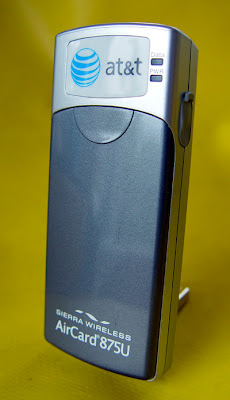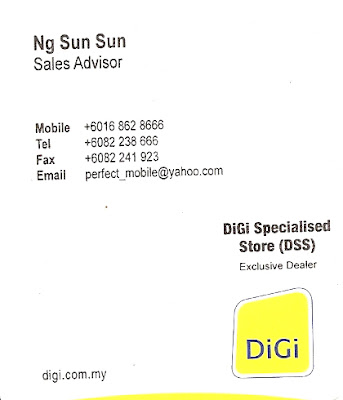 Thailand.
Thailand.We've used GPRS before, but found it prohibitively expensive in Australia and Singapore. This time we purchased a Sierra Wireless Aircard 875u 3G modem, which connects via USB. We fixed on this unit when we realised it was useable worldwide, and that it could be used with an external antenna in areas of marginal signal strength (note that the 875u has now been superceded by the 880u - now with GPS(!) onboard). Click for product data sheet. The external antenna capability is of course very useful on metal boats. Selecting a service provider proved more difficult. Celcom offers a 3G network with very wide regional coverage, whilst DiGi offers a 2G (Edge) service with less regional penetration. Whilst locals in Kuching believed Celcom was sure to be better, we'd heard from data specialists in West Malaysia that the DiGi service was far more reliable. With this in mind we signed up for both - a side-by-side test was sure to be revealing, and so it turned out.
DiGi was the first tested, at the anchorage in Santubong. To our delight we had access speeds superior to many wi-fi networks, and rock solid reliable performance. The Celcom card arrived the next day, but wouldn't work...that would require dealer intervention we were told on the helpline. By then we had departed Santubong for the Rajang, so we continued using the DiGi service. We had reliable internet access for almost one third of the ocean journey to Kampung Rajang, and once in the Rajang River we never lost signal all the way to Bintangor. Leaving the Rajang we headed up the Binatang and then the Tulai Rivers, carefully watching the signal strength drop as distance increased. Anchored at Rumah Lidam it fluctuated between one and three bars, averaging 2 bars. Despite this we have a perfectly reliable (though sometimes slow) GPRS connection, and are delighted with the DiGi service.
After some prodding the Celcom dealer in Kuching advised they'd forgotten to activate the card - duh - and said it would start working soon. Testing the Celcom SIM card the next day gave a different error message (incorrect profile). I figured the APN was wrong in the profile, easily edited if I could find out what it should be. There followed a week of hopeless telephone traffic with Celcom "careline". Eventually an engineer did call, but it took a week. By then we'd got it working with the help of Ghuftrade, a dealer in West Malaysia. Unfortunately, the Celcom service is virtually un-useable up here. Great signal strength (as expected) and great coverage (the 900Mhz Celcom network spreads better than the 1.8ghz DiGi system). However the internet provisioning on the Celcom network (in GPRS areas) we've found
 to be extremely unreliable and inadequate. When it works the speed is no better than DiGi, but it resets frequently. Earlier today I gave it one last try, and could not get it to hold up a service for more than 2 minutes. DiGi will work solidly all day long - we've even downloaded software updates that take hours to transfer.
to be extremely unreliable and inadequate. When it works the speed is no better than DiGi, but it resets frequently. Earlier today I gave it one last try, and could not get it to hold up a service for more than 2 minutes. DiGi will work solidly all day long - we've even downloaded software updates that take hours to transfer.Click here for the Celcom GSM coverage map in the Rajang delta - it may work for voice, but I wouldn't trust it for data. Click here for the DiGi coverage map of the lower Rajang delta - these guys really are too modest - it works in most places along the river, and will work in much of coastal Malaysia, I'm quite sure.
Conclusion ? Go for the DiGi service - it is solid, reliable and works whenever you can get a signal, which is a whole lot better than not working when ever you can get a signal (sorry Celcom). Click here for links to Ghufran's 3G business - he can supply everything you need via mail order and he is, in our experience, absolutely trustworthy (you just need to visit a MayBank to deposit the funds). He's the only person we know with external antenna's in stock. The specialist DiGi dealer we used is identified in the displayed card image (click the card to enlarge) - they'll install the software for you and make sure its working, unlike Celcom. As a foreigner DiGi will insist that you sign up and pre-pay for six months - but do the maths - it's still a good deal, as it will work all over Malaysia. Thanks to Ian & Mona in Kuching, for lots of support and encouragement with this story.
No comments:
Post a Comment
Have something to say ? Let us know your thoughts ....